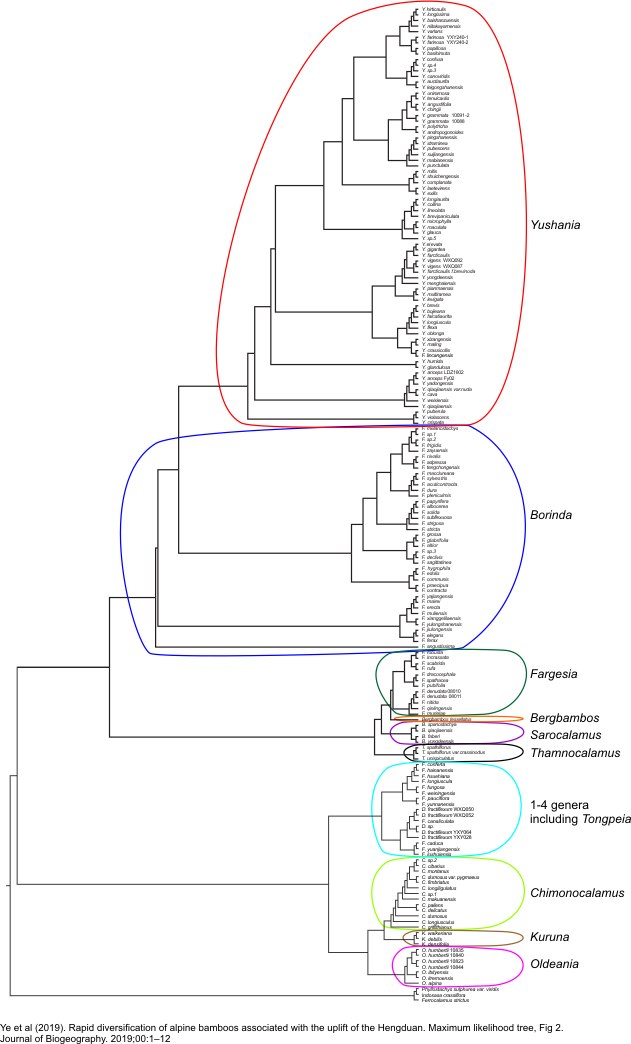|
3. From Guo & Li (2004). Results of combined GBSSI and ITS sequence analysis.
Further work undertaken in Kunming over the years has shown how difficult it is to resolve consistent groups on a phylogenetic basis in the northern temperate clade of bamboos. Conflicts between trees produced by analysis of chloroplast and nuclear genes have made interpretation even harder (Zhang et al 2012).
Nevertheless, a much larger number of bamboos were analysed later, and about a dozen reasonably well supported groups could be somewhat subjectively and tentatively selected for taking seriously as putative nomenclatural groups on the basis of molecular analysis (Zeng et al 2010).
It was only when the introduction of a more powerful technique, genome-wide RAD sequencing, started for bamboos in 2017 (Wang et al 2017) that more reliable results could been achieved. At the same time, the philosophy concerning recognition of genera moved on from a rather dogmatic belief in the overriding importance of phylogeny and monophyletic groups, taking into account the long generation times and abundant hybridisation seen in bamboos. It might even be the case that morphology is coming back into vogue after 2 decades in the wilderness, supported by much better molecular data.
Results of the latest and most comprehensive analysis of temperate Sino-Himalayan bamboos to date (Ye et al. 2019) were presented in a large tree, best zoomed into as pdf rather than viewed directly here. The branches are grouped and labelled into genera according to the joint morphological and phylogenetic classification applied on this website.

References
Guo et al. (2001). Guo, Z.-H., Chen, Y.-Y., Li, D.-Z., and Yang, J.-B. 2001. Genetic variation and evolution of the alpine bamboos (Poaceae: Bambusoideae) using DNA sequence data. Journal of Plant Research 114: 315-322.
Guo et al. (2002). Guo, Z.-H., Chen, Y.-Y., and Li, D.-Z. 2002. Phylogenetic studies on the Thamnocalamus group and its allies (Gramineae: Bambusoideae) based on ITS sequence data. Molecular Phylogenetics and Evolution 22: 20-30.
Guo & Li (2004). Guo, Z.-H., and Li, D.-Z. 2004. Phylogenetics of the Thamnocalamus group and its allies (Gramineae: Bambusoideae): inference from the sequences of GBSSI gene and ITS spacer. Molecular Phylogenetics and Evolution 30: 1-12.
Wang, X., Ye, X., Zhao, L., Li, D., Guo, Z., & Zhuang, H. (2017). Genome-wide RAD sequencing data provide unprecedented resolution of the phylogeny of temperate bamboos (Poaceae: Bambusoideae). Scientific Reports 7(1): 11546. doi: 10.1038/s41598-017-11367-x
Ye, Xia-Ying, Ma, Peng-Fei, Yang, Guo-Qian, Guo, Cen, Zhang, Yu-Xiao, Chen, Yun-Mei, Guo, Zhen-Hua and Li, De-Zhu (2019). Rapid diversification of alpine bamboos associated with the uplift of the Hengduan Mountains. Journal of Biogeography 2019; 00: 1–12. https://doi.org/10.1111/jbi.13723
Zeng, C.X., Zhang Y.X., Triplett, J.K., Yang, J.B., & Li, D.Z. (2010). Large multi-locus plastid phylogeny of the tribe Arundinarieae (Poaceae: Bambusoideae) reveals ten major lineages and low rate of molecular divergence. Molecular Phylogenetics and Evolution 56: 821–839. DOI: 10.1016/j.ympev.2010.03.041
Zhang, Y.J., Zeng, C.Z. & Li, D.Z. (2012). Complex evolution in Arundinarieae (Poaceae: Bambusoideae): Incongruence between plastid and nuclear GBSSI gene phylogenies. Molecular Phylogenetics and Evolution 63(3): 777–797. http://dx.doi.org/10.1016/j.ympev.2012.02.023
|

